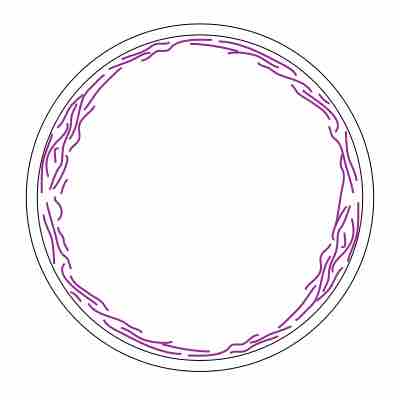FtsZ is a protein encoded by the ftsZ gene that assembles into a ring at the future site of the septum of bacterial cell division. This is a prokaryotic homologue to the eukaryotic protein tubulin. FtsZ has been named after "Filamenting temperature-sensitive mutant Z". The hypothesis was that cell division mutants of E. coli would grow as filaments due to the inability of the daughter cells to separate from one another.
FtsZ was the first protein of the prokaryotic cytoskeleton to be identified. During cell division, FtsZ is the first protein to move to the division site, and is essential for recruiting other proteins that produce a new cell wall between the dividing cells. FtsZ's role in cell division is analogous to that of actin in eukaryotic cell division, but unlike the actin-myosin ring in eukaryotes, FtsZ has no known motor protein associated with it. The origin of the cytokinetic force thus remains unclear, but it is believed that the localized synthesis of new cell wall produces at least part of this force. It is interesting to note that L-form bacteria that lack a cell wall do not require FtsZ for division, which implies that bacteria may have retained components of an ancestral mode of cell division.
Much is known about the dynamic polymerization activities of tubulin and microtubules, but little is known about these activities in FtsZ. While it is known that single-stranded tubulin protofilaments form into 13 stranded microtubules, the multistranded structure of the FtsZ-containing Z-ring is not known. It is only speculated that the structure consists of overlapping protofilaments. Recently, proteins similar to tubulin and FtsZ have been discovered in large plasmids found in Bacillus species. They are believed to function as components of segrosomes, which are multiprotein complexes that partition chromosomes/plasmids in bacteria. The plasmid homologs of tubulin/FtsZ seem to have conserved the ability to polymerize into filaments.

FtsZ Filaments
The Z-ring forms from smaller subunits of FtsZ filaments. These filaments may pull on each other and tighten to divide the cell.
FtsZ has the ability to bind to GTP, and also exhibits a GTPase domain that allows it to hydrolyze GTP to GDP and a phosphate group. In vivo, FtsZ forms filaments with a repeating arrangement of subunits, all arranged head-to-tail. These filaments form a ring around the longitudinal midpoint, or septum, of the cell. This ring is called the Z-ring. The GTP hydrolyzing activity of the protein is not essential to the formation of filaments or division. Mutants lacking the GTPase domain form twisted and disordered septa. These cells with irregular septa can still divide, although abnormally. It is unclear as to whether FtsZ actually provides the physical force that results in division or serves as a marker for other proteins to execute division.
The Z-ring forms from smaller subunits of FtsZ filaments. These filaments may pull on each other and tighten to divide the cell. If FtsZ does provide force that divides the cell, it may do so through the relative movement of subunits. In this model, FtsZ scission force comes from the relative lateral movement of subunits. Lines of FtsZ would line up together parallel and pull on each other creating a "cord" of many strings that tightens itself. In other models, FtsZ does not provide the contractile force but provides the cell a spatial scaffold for other proteins to execute the division of the cell. This is akin to the creating of a temporary structure by construction workers to access hard-to-reach places of a building. The temporary structure allows unfettered access and ensures that the workers can reach all places. If the temporary structure is not correctly built, the workers will not be able to reach certain places, and the building will be deficient.
This "scaffold theory" is supported by information that shows that the formation of the ring and localization to the membrane requires the concerted action of a number of accessory proteins. ZipA or the actin homologue FtsA permit initial FtsZ localization to the membrane. Following localization to the membrane, division proteins of the Fts family are recruited for ring assembly. Many of these proteins, such as FtsW, FtsK, and FtsQ are involved in stabilization of the Z ring and may also be active participants in the scission event. The formation of the Z-ring closely coincides with cellular processes associated with replication.